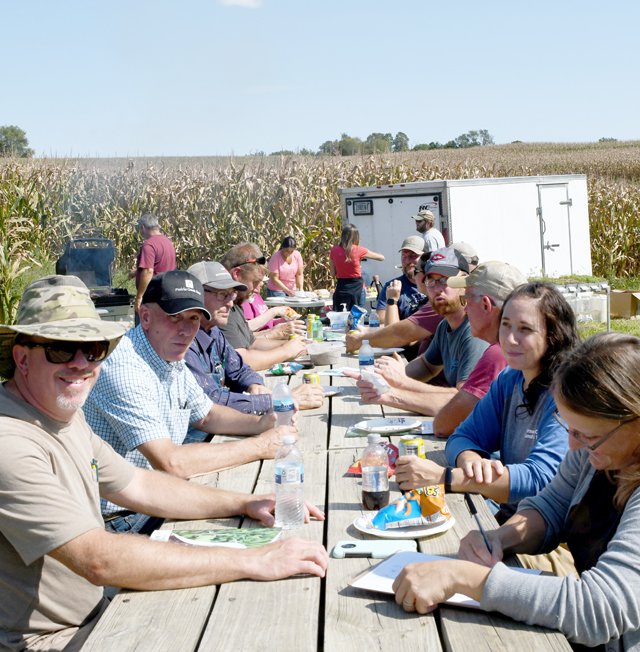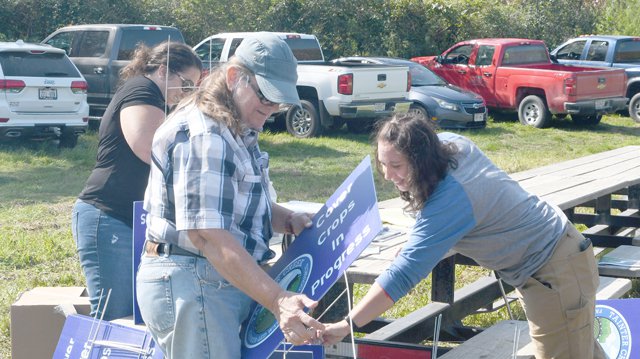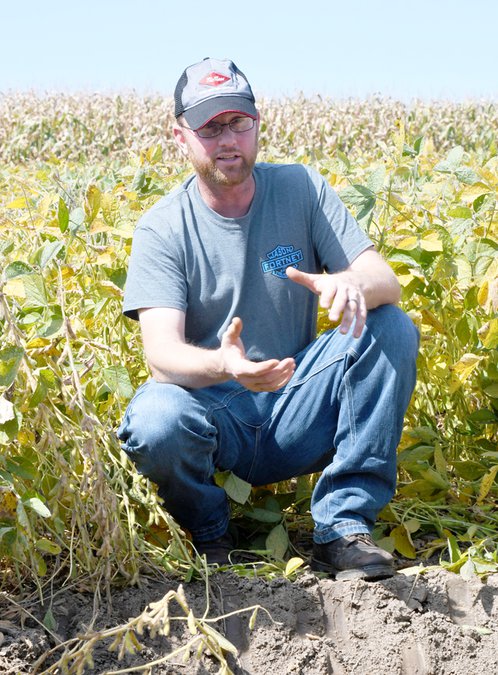Note: the reporter got it wrong, and the anniversary of the flood event was actually September 20.
CRAWFORD AND VERNON COUNTIES - This week’s issue of the Crawford County Independent & Kickapoo Scout goes to press five years to the day from the flood that got the Tainter Creek Watershed Council started. That flash flood resulted from a heavy rainfall event that set up at the Vernon-Crawford county line, and dropped about eleven inches of water overnight between September 15 and 16, 2016.
In the aftermath of that flash flood, which heavily impacted both the Rush Creek and Tainter Creek watersheds, farmers in the Tainter Creek watershed began to get together to talk about what they could do to help mitigate the impacts of increasingly heavy rainfall.
The group has gone on to receive funding from the Wisconsin Department of Agriculture, Trade and Consumer Protection (DATCP) ‘Producer-Led Watershed Council’ program four years in a row. They have increased acres planted in cover crops in the watershed by over 60 percent, resulting in about nine percent of corn and bean acres in the watershed having living roots growing year-round.
In addition, the group has attracted funding from the Wallace Center Pasture Project, for the conversion of cropland in the watershed to managed rotational grazing systems. Despite the pandemic, work has proceeded steadily on the project, and several field days have been held to showcase projects. Ultimately, the Wallace Center will study the connection between increased acres in grass in the watershed and water quality in the creek.
Blockbuster events, orchestrated by the group in 2018 and 2019 included renowned soil health experts Ray Archuleta and Gabe Brown. Last weekend, the group featured renowned Coon Creek soil erosion researcher, Dr. Stanley Trimble – more on that soon. Though COVID put a damper on events in 2020 and 2021, the group has continued to offer field days on member farms showcasing the good work being done.
Last week, the group returned to the farm of Brad Robson, in Hornby Hollow. At that meeting, they learned about soil health from a presentation provided by Carl Delafield of Prairie Creek Seeds, and were treated to a demonstration of the ‘AeroSeeder’ drone cover crop planter, developed by Tom Leitgen of Garnavillo, Iowa.

Signs and lunch
At the event, lunch was provided by farmer host Brad Robson. Robson grilled up grassfed beef burgers from his own cattle raised on the farm. The delicious meal was rounded out with Westby Cooperative Creamery dairy products, and delicious dessert bars made by a watershed council member.

Also unveiled at the event were the new ‘Cover Crops in Progress’ signs in bright blue, containing the watershed council logo. The signs are intended to be displayed on member farms to let the public know that the farmer is employing cover crops on their farm. There was a lively group engaged in assembling the signs.
Soil health
Carl Delafield of Prairie Creek Seeds was back for a second year in a row at the farm of Brad Robson. Two soil pits were dug in fields on Robson’s farm where the effects of soil health initiatives undertaken could be viewed and discussed.
One pit was in a soybean field that had been in corn the year before, and was inter-seeded with cover crops. The other pit was in a corn field that had previously been in a 10-year hay rotation, followed by two years of corn, and one year of oats. Each year, after the cash crops are harvested, Robson and his father turn their herd of 60 beef cattle out on the fields to graze the cover crops as forage over the winter.
“The question of whether a cover crop is for soil health or forage is a question I field a lot in my work,” Delafield said. “The answer is that it can be for both, but the mix you choose to plant can be modified to best achieve your goals for your fields.”
Delafield pointed out that planting cover crops increases soil organic matter, as well as water infiltration in fields where cash crops are grown. He said that the roots of cover crops typically follow earth worm channels in the soil, allowing them to penetrate more deeply into the soil profile. This, in turn, helps to create deeper levels of valuable topsoil in a field, sequesters more carbon, increases nutrients in the soil available to cash crops, and does a better job of handling conditions of too little or too much water.

“The root channels you see in the soil are lined with excrement from earth worms, and those areas in the soil are eight times more fertile than the soil around it,” Bad Axe Watershed farmer Travis Klinkner pointed out.
Robson told the group that Tom Leitgen had planted the field using his Aeroseeder drone planter two weeks ago. Robson said that he had gotten the timing on planting wrong, and planted cover crops too close in time to an herbicide application on an adjacent field, resulting in a partial failure of the cover crop on the field edge.
“Timing in planting of cover crops is everything, and herbicide applications are one of the things you need to take into account,” Delafield said. “Basically, you should plant covers into soybeans when the leaves just begin to get yellow, and into corn when you can see a narrow strip of sunlight between the rows, indicating that the corn leaves are beginning to dehydrate and shrink.”
Delafield said that the time of year that the cover crop is planted is also an important consideration. After about October, Delafield said, in Wisconsin, your options become limited to triticale and winter rye. He said that winter rye can continue to be successfully planted into early December, but that you will achieve a better stand in the spring the earlier in the season the rye is planted.
Drone seeder
Tom Leitgen arrived for the AeroSeeder drone planter demonstration after doing some custom planting in the area in the morning. As a result, there were a few delays while his crew worked to get the device’s lithium ion batteries sufficiently charged.
“The AeroSeeder uses a pair of lithium ion batteries each time we fly it, and when drained, the batteries take four-to-five hours to recharge,” Leitgen explained. “When purchased, the drone seeder comes with two pairs of the batteries.”
Leitgen said that the device can plant a 30-foot swath, and flies about 50 feet above the field. He said that the routes the seeder flies are all pre-programmed on an I-Pad, based on a download of the farm’s FSA map. He said that a drone operator is required to have a Federal Aviation Administration (FAA) license, and is also required to have a spotter when operating the device.
According to Leitgen, the device costs $14,000 to purchase. He currently offers custom seeding services using the device to farmers, at a cost of one dollar per pound of seed applied, but made clear that his main business is in inventing and selling the device, and not in custom planting.
Carl Delafield said that in Iowa he has heard the going rate for drone custom planting of cover crop seed runs about $15-20 per acre.
Drone advantages
According to the AeroSeeder website, “in August and September, a ground-driven rig can’t seed cover crops into corn because the stalks are too tall. On soybeans, some farmers use a high-boy applicator, which risks soil compaction if fields are wet. Also, wheels must stay between the rows to prevent damage to the crop.
“Some farmers are hiring crop dusters to broadcast cover crop seed into a standing row crop. A lot of the cereal rye is being applied by airplanes and helicopters in Iowa.
“Compared to an airplane, the drone is easily transported, is used by a wider customer base and can get into places in fields the larger aircraft can’t reach,” such as terraces, grass waterways and wetlands. And a crop duster isn’t going to fly a plane very far from an airport just to seed 30 or 40 acres.
“The AeroSeeder can carry up to a 30-pound load of seed and cover 100 acres in an eight-hour day. Since the seed weight per pound varies according to type of cover crop, the seed mix determines how many acres you can cover between having to stop and refill.
“Our AeroSeeder drone can carry a 30-pound load of annual ryegrass seed and perform six flights per hour, which can cover about 18 acres. However, the seeding rate can be adjusted based on a farmer’s needs.”
More information on the Aeroseeder can be found at: www.aeroseeder.com




